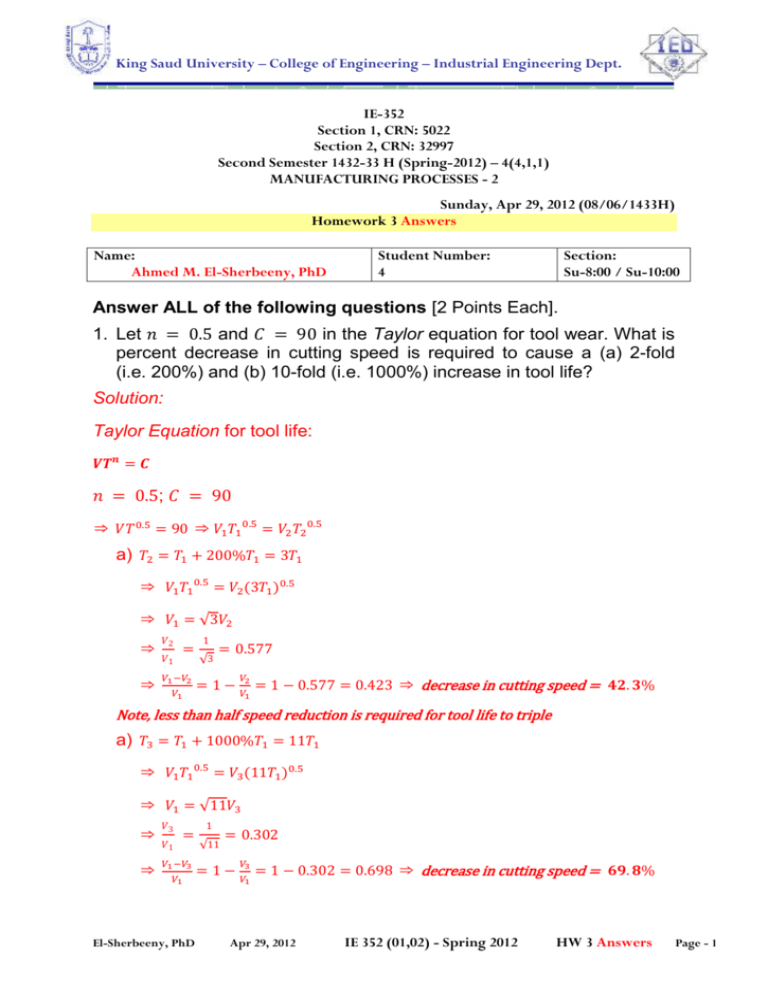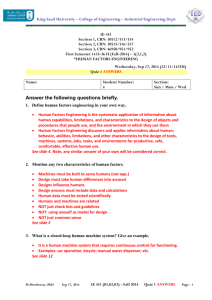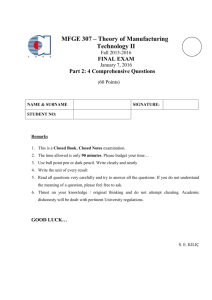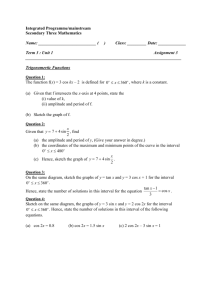Solution
advertisement

King Saud University – College of Engineering – Industrial Engineering Dept. IE-352 Section 1, CRN: 5022 Section 2, CRN: 32997 Second Semester 1432-33 H (Spring-2012) – 4(4,1,1) MANUFACTURING PROCESSES - 2 Sunday, Apr 29, 2012 (08/06/1433H) Homework 3 Answers Name: Ahmed M. El-Sherbeeny, PhD Student Number: 4 Section: Su-8:00 / Su-10:00 Answer ALL of the following questions [2 Points Each]. 1. Let 𝑛 = 0.5 and 𝐶 = 90 in the Taylor equation for tool wear. What is percent decrease in cutting speed is required to cause a (a) 2-fold (i.e. 200%) and (b) 10-fold (i.e. 1000%) increase in tool life? Solution: Taylor Equation for tool life: 𝑽𝑻𝒏 = 𝑪 𝑛 = 0.5; 𝐶 = 90 ⇒ 𝑉𝑇 0.5 = 90 ⇒ 𝑉1 𝑇1 0.5 = 𝑉2 𝑇2 0.5 a) 𝑇2 = 𝑇1 + 200%𝑇1 = 3𝑇1 ⇒ 𝑉1 𝑇1 0.5 = 𝑉2 (3𝑇1 )0.5 ⇒ 𝑉1 = √3𝑉2 ⇒ 𝑉2 ⇒ 𝑉1 −𝑉2 𝑉1 = 𝑉1 1 √3 = 0.577 = 1 − 𝑉2 = 1 − 0.577 = 0.423 ⇒ decrease in cutting speed = 𝟒𝟐. 𝟑% 𝑉 1 Note, less than half speed reduction is required for tool life to triple a) 𝑇3 = 𝑇1 + 1000%𝑇1 = 11𝑇1 ⇒ 𝑉1 𝑇1 0.5 = 𝑉3 (11𝑇1 )0.5 ⇒ 𝑉1 = √11𝑉3 ⇒ 𝑉3 ⇒ 𝑉1 −𝑉3 𝑉1 = 𝑉1 El-Sherbeeny, PhD 1 √11 = 0.302 = 1 − 𝑉3 = 1 − 0.302 = 0.698 ⇒ decrease in cutting speed = 𝟔𝟗. 𝟖% 𝑉 1 Apr 29, 2012 IE 352 (01,02) - Spring 2012 HW 3 Answers Page - 1 King Saud University – College of Engineering – Industrial Engineering Dept. 2. In an orthogonal cutting operation, spindle speed is set to provide a cutting speed of 1.8 m/s. The width and depth of cut are 2.6 mm and 0.30 mm, respectively. The tool rake angle is 8°. After the cut, the deformed chip thickness is measured to be 0.49 mm. Determine (a) shear plane angle, (b) shear strain, and (c) material removal rate. Given: 𝑚 cutting speed: 𝑉 = 1.8 𝑠 width: 𝑤 = 2.6 𝑚𝑚 thicknesses: 𝑡0 = 0.30 𝑚𝑚, 𝑡𝑐 = 0.49 𝑚𝑚 rake angle: = 8° Required: a) =? b) =? c) 𝑅𝑀𝑅 =? Solution: a) can be obtained from: 𝑟 cos tan = 1 − 𝑟 sin 𝑡𝑜 0.30 𝑚𝑚 𝑟= = = 0.612 𝑡𝑐 0.49 𝑚𝑚 ⇒ = tan−1 [ 0.612 cos 8° 1−0.612 sin 8° ] = tan−1 0.663 ⇒ = 𝟑𝟑. 𝟓° b) can be obtained from: = cot + tan( − ) ⇒ = cot 33.5° + tan(33.5° − 8°) ⇒ = 𝟏. 𝟗𝟖𝟕 c) 𝑅𝑀𝑅 (material removal rate) is the volume of material removed (i.e. cut) every second which can be obtained from: 𝑅𝑀𝑅 = 𝑤𝑡𝑜 𝑉 = (2.6 𝑚𝑚)(0.30 𝑚𝑚)[(1.8 𝑚⁄𝑠)(1000 𝑚𝑚⁄𝑚)] ⇒𝑹𝑴𝑹 = 𝟏𝟒𝟎𝟒 El-Sherbeeny, PhD Apr 29, 2012 IE 352 (01,02) - Spring 2012 𝒎𝒎𝟑 HW 3 Answers 𝒔 Page - 2 King Saud University – College of Engineering – Industrial Engineering Dept. 3. Assume that, in orthogonal cutting, the rake angle is 25° and the coefficient of friction is 0.2. Use the cutting ratio equation to determine the percentage increase in chip thickness when the friction is doubled. Given: rake angle: = 25° coefficients of friction: µ1 = 0.2, µ2 = 2µ1 = 0.4 Required: percentage increase in chip thickness 𝑡𝑐 −𝑡𝑐 𝑡𝑐 i.e. 2 1 = 2 − 1 =? 𝑡 𝑐1 𝑡 𝑐1 Solution: cutting ratio equation: 𝑡𝑜 sin 𝑟= = 𝑡𝑐 cos( − ) Rearranging: ⇒𝑡𝑐 = 𝑡𝑜 cos(−) sin Assuming rake angle () and depth of cut (𝑡𝑜 ) are kept constant⇒ 𝑡𝑐2 = 𝑡𝑐1 𝑡𝑜 𝑡𝑜 cos(2 − ) sin 2 cos(1 − ) sin 1 = cos(2 − ) sin 1 cos(1 − ) sin 2 We lack the values for the shear angles(1 and 2 ), so we use: 𝛽 2 2 Note how we use this equation since µ1 and µ2 < 0.5 = 45° + − Also, note: 𝛽1 = tan−1 µ1 = tan−1 0.2 = 11.31° 𝛽2 = tan−1 µ2 = tan−1 0.4 = 21.80° ⇒ 𝛽1 25° 11.31° = 45° + − = 51.85° 2 2 2 2 𝛽2 25° 21.80° 2 = 45° + − = 45° + − = 46.60° 2 2 2 2 1 = 45° + El-Sherbeeny, PhD − Apr 29, 2012 IE 352 (01,02) - Spring 2012 HW 3 Answers Page - 3 King Saud University – College of Engineering – Industrial Engineering Dept. Substituting in chip thickness formula we generated⇒ 𝑡𝑐2 cos(46.60° − 25°) sin 51.85° = = 1.13 𝑡𝑐1 cos(51.85° − 25°) sin 46.60° ⇒ increase in chip thickness= El-Sherbeeny, PhD Apr 29, 2012 𝑡 𝑐2 𝑡 𝑐1 − 1 = 1.13 − 1 = 𝟏𝟑% IE 352 (01,02) - Spring 2012 HW 3 Answers Page - 4 King Saud University – College of Engineering – Industrial Engineering Dept. 4. A turning operation is performed on stainless steel with hardness 200 HB (with specific energy of 2.8 J/mm3), cutting speed = 200 m/min, feed = 0.25 mm/rev, and depth of cut = 7.5 mm. How much power will the lathe draw in performing this operation if its mechanical efficiency is 90%? Given: total specific energy: 𝑢𝑡 = 2.8 cutting speed: 𝑉 = 200 𝑚𝑚 𝑚 𝐽 𝑚𝑚3 𝑚𝑖𝑛 feed: 𝑓 = 0.25 𝑟𝑒𝑣 depth of cut: 𝑡0 = 7.5 𝑚𝑚 mechanical efficiency: 𝜂𝑚𝑒𝑐ℎ = 90% Required: Total power drawn from source: 𝑃𝑜𝑤𝑒𝑟𝑠𝑜𝑢𝑟𝑐𝑒 =? Solution: cutting power is related to power from source through: 𝑃𝑜𝑤𝑒𝑟𝑐 = 𝑃𝑜𝑤𝑒𝑟𝑠𝑜𝑢𝑟𝑐𝑒 ∗ 𝜂𝑚𝑒𝑐ℎ or 𝑃𝑜𝑤𝑒𝑟𝑐 𝑃𝑜𝑤𝑒𝑟𝑠𝑜𝑢𝑟𝑐𝑒 = 𝜂𝑚𝑒𝑐ℎ also, total specific energy: 𝑡𝑜𝑡𝑎𝑙 𝑐𝑢𝑡𝑡𝑖𝑛𝑔 𝑝𝑜𝑤𝑒𝑟 𝑃𝑜𝑤𝑒𝑟𝑐 𝑢𝑡 = = 𝑚𝑎𝑡𝑒𝑟𝑖𝑎𝑙 𝑟𝑒𝑚𝑜𝑣𝑎𝑙 𝑟𝑎𝑡𝑒 𝑅𝑀𝑅 o Since turning operation is involved ⇒ 𝑅𝑀𝑅 = 𝑓𝑡0 𝑉 𝑚 𝑚𝑚 𝑚𝑖𝑛 = (0.25 𝑚𝑚)(7.5 𝑚𝑚) [(200 ) (1000 )( )] 𝑚𝑖𝑛 𝑚 60 𝑠𝑒𝑐 𝑚𝑚3 = 6250 𝑠 o Thus, 𝐽 𝑚𝑚3 𝐽 𝑃𝑜𝑤𝑒𝑟𝑐 = 𝑢𝑡 ∗ 𝑅𝑀𝑅 = (2.8 = 17500 ) (6250 ) 𝑚𝑚3 𝑠 𝑠 = 17.5 𝑘𝑊 Substituting into the source power equation: 𝑃𝑜𝑤𝑒𝑟𝑐 17.5 𝑘𝑊 𝑷𝒐𝒘𝒆𝒓𝒔𝒐𝒖𝒓𝒄𝒆 = = = 𝟏𝟗. 𝟒𝟒 𝒌𝑾 𝜂𝑚𝑒𝑐ℎ 0.9 El-Sherbeeny, PhD Apr 29, 2012 IE 352 (01,02) - Spring 2012 HW 3 Answers Page - 5 King Saud University – College of Engineering – Industrial Engineering Dept. 5. With a carbide tool, the temperature in a cutting operation is measured as 650°C when the speed is 90 m/min and the feed is 0.05 mm/rev. What is the approximate temperature if the speed is doubled? What speed is required to lower the maximum cutting temperature to 480°C? Given: first operation: o cutting temperature: 𝑇1 = 650 °𝐶 𝑚 o cutting speed: 𝑉1 = 90 o feed: 𝑓 = 0.05 𝑚𝑖𝑛 𝑚𝑚 𝑟𝑒𝑣 Required: a) second operation: o 𝑉2 = 2𝑉1 o 𝑇2 =? b) third operation: o 𝑇3 = 480 °𝐶 o 𝑉3 =? Solution: equation for mean temperature in orthogonal cutting (note, it is mentioned if it is turning on a lathe or not): 0.000665𝑌𝑓 3 𝑉𝑡0 √ 𝜌𝑐 𝐾 𝑇= since, 𝑌𝑓 , 𝜌𝑐, 𝐾 are material dependent, and assuming constant depth of cut (𝑡0 ) and rearranging equation above: 𝑇 3 √𝑉 = 0.000665𝑌𝑓 3 𝑡0 √ =𝐶 𝜌𝑐 𝐾 Thus, 𝑇1 3 √𝑉1 = El-Sherbeeny, PhD 𝑇2 3 √𝑉2 Apr 29, 2012 IE 352 (01,02) - Spring 2012 HW 3 Answers Page - 6 King Saud University – College of Engineering – Industrial Engineering Dept. a) second operation: 3 𝑇2 = √𝑉2 3 2𝑉 3 1 √ 𝑇 = 𝑇 = √2𝑇1 = (1.26)(650 °𝐶) 1 1 3 𝑉 𝑉 1 √ 1 ⇒𝑻𝟐 = 𝟖𝟏𝟗 °𝑪 b) third operation: 𝑇3 3 480 °𝐶 3 3 √90 = 3.309 √𝑉3 = √𝑉1 = 𝑇1 650 °𝐶 ⇒ 𝑉3 = 3.3093 ⇒ 𝑽𝟑 = 𝟑𝟔. 𝟐 𝒎 𝒎𝒊𝒏 Alternative Solution: assuming this was a turning operation, and using equation for mean temperature in turning on a lathe 𝑇𝑚𝑒𝑎𝑛 𝑉 𝑎 𝑓 𝑏 or: 𝑇𝑚𝑒𝑎𝑛 = 𝐶 𝑉 𝑎 𝑓 𝑏 assuming constant feed (𝑓), and using 𝑎 = 0.2, 𝑏 = 0.125 (since given that this is carbide tool) ⇒𝑇𝑚𝑒𝑎𝑛 = 𝐶 𝑉 𝑎 𝑓 𝑏 𝑇𝑚𝑒𝑎𝑛 1 𝑉10.2 = 𝑇𝑚𝑒𝑎𝑛 2 𝑉20.2 a) second operation: 𝑇𝑚𝑒𝑎𝑛 2 𝑉20.2 2𝑉1 0.2 = 0.2 𝑇𝑚𝑒𝑎𝑛1 = ( ) 𝑇𝑚𝑒𝑎𝑛1 = (20.2 )(𝑇𝑚𝑒𝑎𝑛 1 ) 𝑉1 𝑉1 = (1.15)(650 °𝐶) ⇒𝑻𝟐 = 𝟕𝟒𝟕 °𝑪 b) third operation: 𝑇3 480 °𝐶 0.2 𝑉30.2 = 𝑉10.2 = 90 = 1.816 𝑇1 650 °𝐶 El-Sherbeeny, PhD Apr 29, 2012 IE 352 (01,02) - Spring 2012 HW 3 Answers Page - 7 King Saud University – College of Engineering – Industrial Engineering Dept. 1 ⇒ 𝑉3 = 1.8160.2 = 1.8165 ⇒ 𝑽𝟑 = 𝟏𝟗. 𝟖 𝒎 𝒎𝒊𝒏 Note that the second solution did not produce a significantly large difference in final temperature, and yet a large difference in cutting speeds. El-Sherbeeny, PhD Apr 29, 2012 IE 352 (01,02) - Spring 2012 HW 3 Answers Page - 8







